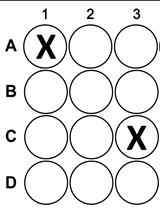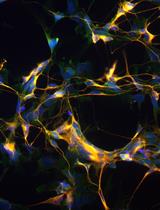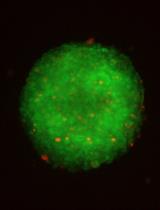- EN - English
- CN - 中文
Mito Stress Assay of PBMCs With Seahorse XFe96 Flux Analyzer and Comparison of Poly-D-Lysine and Poly-L-Lysine for Cell Affinity
利用Seahorse XFe96通量分析仪检测PBMC的线粒体应激反应,并比较Poly-D-Lysine与Poly-L-Lysine的细胞附着性能
发布: 2025年06月05日第15卷第11期 DOI: 10.21769/BioProtoc.5327 浏览次数: 1892
评审: Komuraiah MyakalaRudian ZhangAnonymous reviewer(s)
Abstract
The Seahorse 96 XF Analyzer (Agilent Technologies, Santa Clara, CA, USA) has been an effective tool in non-invasively measuring mitochondrial function for the past decade. It is a high-throughput respirometer that is considered the “gold standard” for quantifying mitochondrial function and bioenergetics in cells. Peripheral blood mononuclear cells (PBMCs) play a selective role in immune system responses and are key components of human immunity. Recent studies have suggested that these cell populations provide an overview of systemic changes within the body and therefore provide a source of sensitive biomarkers. Assessing mitochondrial function in PBMCs has been shown to provide an indication of metabolic stress associated with diseases such as diabetes and neurodegenerative conditions such as Alzheimer’s disease. In this protocol, we use two adhesive compounds, Poly-D-Lysine (PDL) and Poly-L-Lysine (PLL), at 50 μg/mL each per well, to immobilize PBMCs to a specialized Seahorse microplate to perform mitochondrial stress assay using the Seahorse Analyzer. We compared six cell densities of PBMCs to identify the optimal cell density for use in Seahorse Mito Stress analysis. This protocol includes the immobilization of freshly isolated PBM cells into a Seahorse microplate, hydration and calibration of the sensor cartridge, cell seeding, running the Seahorse Analyzer for the Mito Stress test, and simple data analysis to compare the effectiveness of PLL and PDL as the coating agent for PBMCs. The data analysis indicates that there is no statistical difference between PLL and PDL.
Key features
• Designed for Seahorse 96-XF Analyzer, allowing it to work with lower cell densities and accommodate a greater number of replicates with high-throughput capabilities.
• Two widely used cell adhesive compounds, Poly-D-Lysine and Poly-L-Lysine, are compared for their effectiveness in immobilizing PBMCs onto specialized Seahorse microplates.
• The protocol takes two days to complete.
Keywords: Seahorse 96 XF Analyzer (Seahorse XFe96分析仪)Background
The mitochondria, the powerhouse of the cell, contain a double membrane, termed the outer and inner mitochondrial membranes. Cellular health and function depend largely on mitochondrial function. Mitochondria not only produce energy through oxidative phosphorylation but are also involved in the metabolism of amino acids, lipids, and nucleotides, diverse signaling and redox processes, and quality control and degradation mechanisms, including mitophagy and apoptosis [1]. They can be disrupted in many common diseases, including psychiatric and neurodegenerative disorders, persistent systemic inflammation, cardiac disease, cancer, and diabetes [2]. Oxidative stress and mitochondrial damage have also been implicated in the pathogenesis of several neurodegenerative diseases, including Alzheimer's disease [3].
The Seahorse 96 XF Analyzer (Agilent Technologies, Santa Clara, CA, USA) has been an effective tool in non-invasively measuring mitochondrial function for the past decade [4]. It is a high-throughput respirometer that is considered the “gold standard” for quantifying mitochondrial function and bioenergetics in cells [5–7]. It measures two key outcomes simultaneously—oxygen consumption rate (OCR) and extracellular acidification rate (ECAR)—and includes assays specifically designed to stress cells and measure metabolic potential (Agilent). The Mitochondrial Stress Test kit, designed by Agilent Technologies, offers three modulators that are introduced into the cell system to produce distinct measurements by shutting down each of the complexes in the electron transport chain in reverse order [8].
Initial addition of oligomycin blocks ATP synthase in the mitochondrial inner membrane and inhibits its function in chemiosmosis. Then, carbonyl cyanide-p-trifluoromethoxyphenylhydrazone (FCCP), an uncoupler, is added to the system, selectively removing the regulation of the proton gradient. This allows the maximum respiration rate to be determined. Finally, rotenone and antimycin A are added, which will inhibit complex I and III, respectively, of the electron transport chain [9]. The generated curve for the oxygen consumption rate can be used to obtain various measurements, including basal respiration, ATP turnover, proton leak, maximal respiration, spare respiratory capacity, and non-mitochondrial respiration.
Peripheral blood mononuclear cells (PBMCs) provide selective responses to the immune system and are major cells in the human body’s immunity. They are a heterogeneous cell population consisting of several cell types, including monocytes, T cells, and natural killer cells [10,11]. Assessing OCR and ECAR values in PBMCs has been shown to indicate metabolic stress associated with conditions such as diabetes and neurodegenerative diseases such as Alzheimer’s disease [12–14].
When using PBMCs in Seahorse analysis, it is important to choose an appropriate adhesive compound to immobilize the cells in the Seahorse microplate. Poly-D-Lysine (PDL) is widely used with PBMCs, but limited literature is available on the use of Poly-L-Lysine (PLL). PDL and PLL are the two enantiomers of a synthetic, positively charged polymer called polylysine. Cellular proteases do not degrade PDL, making it the preferred choice in many cases. Both PDL and PLL are useful in promoting cell adhesion to solid substrates and enhancing electrostatic interactions between negatively charged ions of the cell membrane and positively charged surface ions of attachment factors on the culture surface. When adsorbed to the polystyrene surface, poly-D (or L)-lysine increases the number of positively charged sites available for cell binding. Certain cell types prefer this uniform net positive charge, which can subsequently enhance their cell attachment, growth, and differentiation, especially under serum-free and/or low serum conditions. An array of transfected cell lines, glial cells, primary neurons, and neuroblastomas all frequently exhibit improved adhesion and development on surfaces coated with PDL or PLL [15].
Conducting molecular analysis and assays on PBMCs can be challenging, as they are known to be associated with challenges in maintaining cell viability with multiple handling steps throughout the workflow. Many small-scale laboratories are having difficulty finding protocols that allow them to utilize their limited resources to successfully conduct analysis on PBMCs with improved cell viability and feasible consumables. Many small-scale laboratories like ours that conduct Seahorse Flux Analyzer assays using neuronal cell lines utilize PLL as the primary cell coating agent, which is readily available in the laboratory [8,16–18]. Our objective is to compare PDL (primarily recommended for PBMCs in the literature) and our lab’s available PLL to see if it would be a suitable substitute for PDL. If confirmed, additional purchasing of a coating agent could be avoided for laboratories that utilize a wide range of cell types, including PBMCs, in the Seahorse Flux Analyzer. Therefore, in this protocol paper, our primary goal is to present a simple protocol for conducting Mito Stress assay on PBMCs using the Seahorse 96 XF Analyzer, using two commonly available adhesive compounds, PDL and PLL, and compare their effectiveness in the immobilization of freshly isolated PBMCs.
Materials and reagents
Reagents
1. Seahorse XF RPMI Assay Medium pack, pH 7.4; includes one of each of the following products: XF RPMI medium pH 7.4, 500 mL (103576-100), XF 1.0 M glucose solution, 50 mL (103577-100), XF 100 mM pyruvate solution, 50 mL (103578-100), and XF 200 mM glutamine solution, 50 mL (103579-100) (Agilent Technologies, catalog number: 103681-100)
2. Seahorse XF Cell Mito Stress Test kit; each kit contains six single-use pouches. Each pouch contains one vial of oligomycin, FCCP, and rotenone/antimycin A (Agilent Technologies, catalog number: 103015-100)
3. RPMI 1640 medium (Thermo Fisher Scientific, catalog number: 11875093)
4. Penicillin-streptomycin (10,000 U/mL-10,000 μg/mL) (Thermo Fisher Scientific, catalog number: 15140122)
5. FBS stock, heat inactivated (Thermo Fisher Scientific, catalog number: 10082147)
6. Distilled water, 1,000 mL (Thermo Fisher Scientific, catalog number: 15230147)
7. Trypan blue solution 0.4% (Thermo Fisher Scientific, catalog number: 15250061)
8. Poly-D-Lysine (PDL) solution, 1.0 mg/mL, 20 mL (Sigma-Aldrich, catalog number: A-003-E)
9. Poly-L-lysine (PLL) solution, 0.01% (w/v), 50 mL (Sigma-Aldrich, catalog number: P4832-50ML)
Laboratory supplies
1. Seahorse XFe96/XF Pro FluxPak Mini; includes six XFe96/XF Pro sensor cartridges, six XFe96/XF Pro cell culture microplates, and one bottle of Seahorse XF calibrant solution, 500 mL (Agilent Technologies, catalog number: 103793-100)
2. NuncTM 15 mL conical sterile polypropylene centrifuge tubes (Thermo Fisher Scientific, catalog number: 339650)
3. Microcentrifuge tubes, 1.5 and 5 mL (USA Scientific, catalog numbers: 4043-1021 and 4011-9401)
4. Micropipette tips, 10, 20, 200, and 1,000 μL (USA Scientific, catalog numbers: 1181-3810, 1180-1810, 1180-8810, and 1182-1830)
Equipment
1. Seahorse 96 XF Analyzer (Agilent Technologies, Santa Clara, CA, USA)
2. Zeiss Invertoskop microscope (Carl Zeiss, catalog number: 3826000125)
3. Water bath (Thermo Fisher Scientific, model: TSGP10)
4. Incubator without CO2 (Benchmark Scientific, model: H2200-GROUP)
5. Centrifuge (Thermo Fisher, catalog number: 75004538)
6. Micropipettes: 10, 20, 200, and 1,000 μL (Denville Scientific, catalog numbers: P3950-10A, P3950-20A, P3950-200A, and P3950-1000A)
7. Hemocytometer (Nikon, model: TMS No. 215441)
Software and datasets
1. Wave Controller Software (Agilent Technologies, version 2.6.3)
Procedure
文章信息
稿件历史记录
提交日期: Feb 26, 2025
接收日期: Apr 28, 2025
在线发布日期: May 20, 2025
出版日期: Jun 5, 2025
版权信息
© 2025 The Author(s); This is an open access article under the CC BY-NC license (https://creativecommons.org/licenses/by-nc/4.0/).
如何引用
Subasinghe, K., Berry III, R., Rowe, M., Winters, A., Yang, S. and Phillips, N. (2025). Mito Stress Assay of PBMCs With Seahorse XFe96 Flux Analyzer and Comparison of Poly-D-Lysine and Poly-L-Lysine for Cell Affinity. Bio-protocol 15(11): e5327. DOI: 10.21769/BioProtoc.5327.
分类
细胞生物学 > 细胞新陈代谢 > 呼吸测量法
细胞生物学 > 基于细胞的分析方法
您对这篇实验方法有问题吗?
在此处发布您的问题,我们将邀请本文作者来回答。同时,我们会将您的问题发布到Bio-protocol Exchange,以便寻求社区成员的帮助。
Share
Bluesky
X
Copy link












